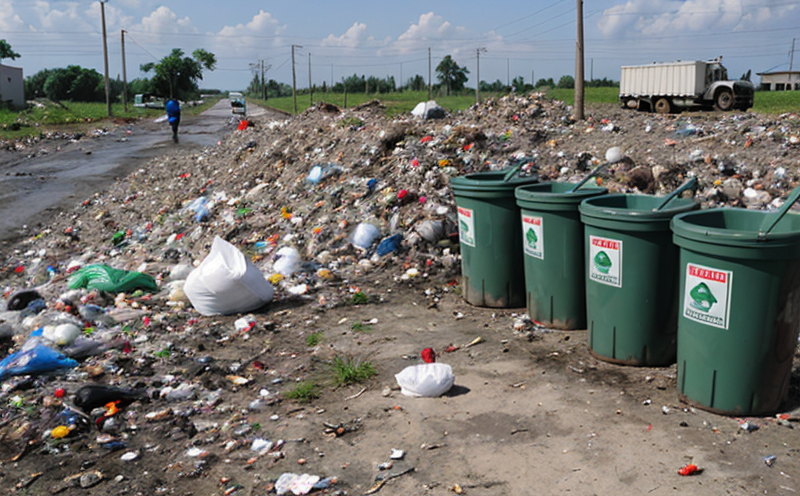DIN 38414-8 Adsorbable Organic Iodine AOI in Solid Waste Test
The DIN 38414-8 standard is a crucial tool for environmental testing, particularly when assessing the presence of adsorbable organic iodine (AOI) in solid waste. This test evaluates the potential release of iodine compounds from solid waste materials under specific conditions. AOI has been identified as an important indicator of certain pollutants that can pose risks to both human health and the environment.
The method outlined in DIN 38414-8 is designed to provide a standardized approach for measuring the adsorbable organic iodine content, ensuring consistency and reliability across various testing facilities. This standard is widely used by industries involved in waste management, environmental consulting firms, research institutions, and regulatory bodies.
The test involves several key steps: first, the solid waste sample must be prepared according to specified procedures. Then, it undergoes a leaching process designed to release any iodine compounds bound within the material. The released iodine is then quantified using a colorimetric or titrimetric method.
Understanding the adsorbable organic iodine content in solid waste is essential for several reasons. It helps identify potential sources of contamination, assesses compliance with environmental regulations, and informs decisions regarding waste treatment and disposal methods. The test results can also guide further research into the behavior and fate of iodine compounds in different waste streams.
The DIN 38414-8 standard ensures that all testing facilities follow a consistent protocol, which is critical for accurate and comparable data. This consistency is particularly important when multiple laboratories are involved in assessing the same samples or when regulatory bodies need to review compliance data from various sources.
By adhering to this standard, quality managers, compliance officers, R&D engineers, and procurement teams can ensure that their waste management practices align with best industry practices. This not only helps meet regulatory requirements but also contributes to more sustainable environmental policies.
The DIN 38414-8 method is applicable to a wide range of solid waste materials, including municipal solid waste, industrial by-products, and hazardous waste. The test can be particularly useful in identifying potential hotspots for further investigation or remediation efforts.
Why It Matters
The measurement of adsorbable organic iodine (AOI) is crucial for understanding the environmental impact of solid waste. AOI can be indicative of certain pollutants that may leach into groundwater or surface water, posing risks to both aquatic ecosystems and human health.
By identifying these potential contaminants early on, stakeholders can take proactive measures to mitigate risks. This includes improving waste treatment processes, selecting more environmentally friendly materials, and implementing stricter monitoring protocols.
The DIN 38414-8 test provides a reliable method for quantifying AOI in solid waste samples, which is essential for regulatory compliance and environmental management. It helps ensure that waste disposal practices are safe and sustainable, contributing to the overall goal of reducing environmental impact.
Understanding the presence and concentration of AOI in solid waste can also inform research efforts aimed at developing new technologies for waste treatment and recycling. This knowledge can lead to innovations that enhance resource efficiency and minimize the release of harmful substances into the environment.
Industry Applications
- Municipal solid waste management
- Industrial by-product disposal
- Hazardous waste treatment facilities
- Environmental consulting firms
- Regulatory bodies and agencies
- R&D in environmental science
- Manufacturing sectors with significant waste production
The DIN 38414-8 test is particularly relevant for industries that generate large quantities of solid waste, such as manufacturing plants, chemical processing facilities, and mining operations. These sectors often need to ensure their waste management practices comply with local regulations and best industry practices.
Environmental consulting firms can use the results from this test to provide clients with detailed assessments of potential environmental risks associated with specific waste streams. Regulatory bodies may also rely on AOI measurements when setting standards for solid waste disposal or evaluating compliance reports submitted by regulated entities.
Environmental and Sustainability Contributions
- The DIN 38414-8 test helps in the identification of potential pollutants that could harm the environment.
- It supports the development of more sustainable waste management practices by providing data for decision-making.
- The results contribute to regulatory compliance, ensuring that waste disposal methods meet environmental protection standards.
- The information derived from this test can be used in research aimed at improving recycling and resource recovery processes.
By using the DIN 38414-8 method, stakeholders can work towards a more sustainable future. This includes reducing the overall environmental footprint of waste management practices and promoting circular economy principles.
The test also plays a role in identifying areas for improvement in current waste treatment technologies. By pinpointing specific contaminants like AOI, researchers and engineers can focus on developing solutions that minimize their release into the environment.





